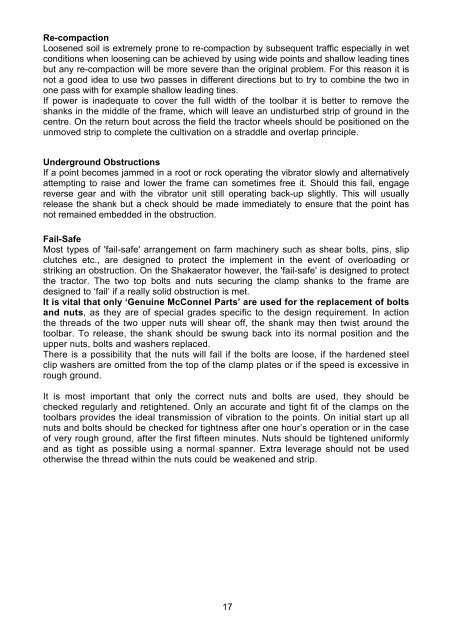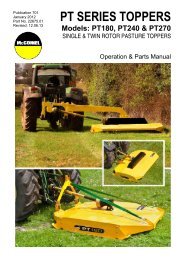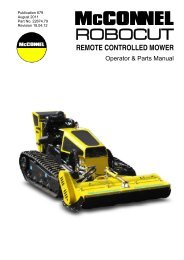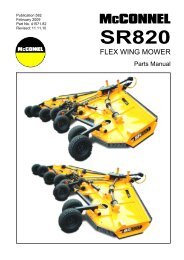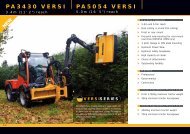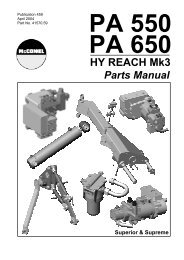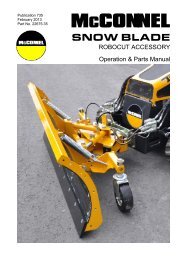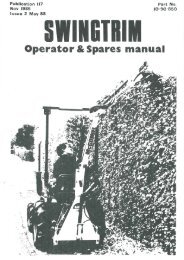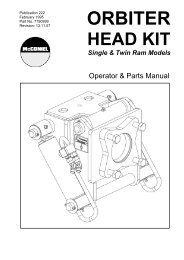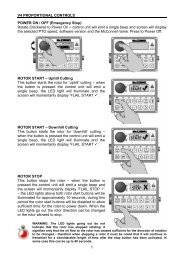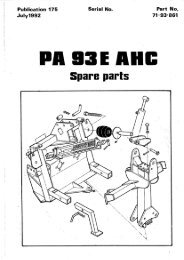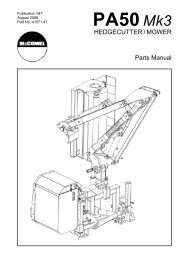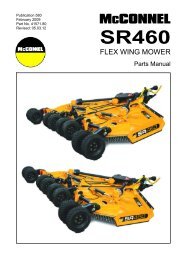SHAKAERATOR - Operator Manual - McConnel
SHAKAERATOR - Operator Manual - McConnel
SHAKAERATOR - Operator Manual - McConnel
- No tags were found...
Create successful ePaper yourself
Turn your PDF publications into a flip-book with our unique Google optimized e-Paper software.
Re-compactionLoosened soil is extremely prone to re-compaction by subsequent traffic especially in wetconditions when loosening can be achieved by using wide points and shallow leading tinesbut any re-compaction will be more severe than the original problem. For this reason it isnot a good idea to use two passes in different directions but to try to combine the two inone pass with for example shallow leading tines.If power is inadequate to cover the full width of the toolbar it is better to remove theshanks in the middle of the frame, which will leave an undisturbed strip of ground in thecentre. On the return bout across the field the tractor wheels should be positioned on theunmoved strip to complete the cultivation on a straddle and overlap principle.Underground ObstructionsIf a point becomes jammed in a root or rock operating the vibrator slowly and alternativelyattempting to raise and lower the frame can sometimes free it. Should this fail, engagereverse gear and with the vibrator unit still operating back-up slightly. This will usuallyrelease the shank but a check should be made immediately to ensure that the point hasnot remained embedded in the obstruction.Fail-SafeMost types of 'fail-safe' arrangement on farm machinery such as shear bolts, pins, slipclutches etc., are designed to protect the implement in the event of overloading orstriking an obstruction. On the Shakaerator however, the 'fail-safe' is designed to protectthe tractor. The two top bolts and nuts securing the clamp shanks to the frame aredesigned to ‘fail’ if a really solid obstruction is met.It is vital that only ‘Genuine <strong>McConnel</strong> Parts’ are used for the replacement of boltsand nuts, as they are of special grades specific to the design requirement. In actionthe threads of the two upper nuts will shear off, the shank may then twist around thetoolbar. To release, the shank should be swung back into its normal position and theupper nuts, bolts and washers replaced.There is a possibility that the nuts will fail if the bolts are loose, if the hardened steelclip washers are omitted from the top of the clamp plates or if the speed is excessive inrough ground.It is most important that only the correct nuts and bolts are used, they should bechecked regularly and retightened. Only an accurate and tight fit of the clamps on thetoolbars provides the ideal transmission of vibration to the points. On initial start up allnuts and bolts should be checked for tightness after one hour’s operation or in the caseof very rough ground, after the first fifteen minutes. Nuts should be tightened uniformlyand as tight as possible using a normal spanner. Extra leverage should not be usedotherwise the thread within the nuts could be weakened and strip.17


